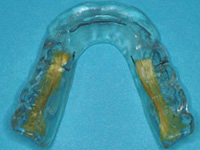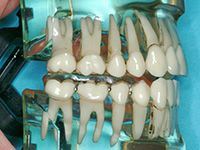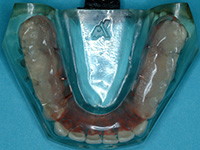Temporomandibular Disorder
Millions of Americans suffer from chronic facial and neck pain as well as severe, recurring headaches. In some cases, this pain is due to Temporomandibular Disorder, also known as TMD.
Your temporomandibular joints, or TMJs, connect your lower jawbone to your skull. These joints get a lot of use throughout the day as you speak, chew, swallow, and yawn. Pain in and around these joints can be unpleasant and may even restrict movement.
Symptoms of TMD include:
- Pain in the jaw area
- Pain, ringing, or stuffiness in the ears
- Frequent headaches or neck aches
- Clicking or popping sound when the jaw moves
- Muscle spasms in the jaw area
- A change in the alignment of top and bottom teeth
- Locked jaw or limited opening of the mouth
If you notice that you are experiencing any of these symptoms, let your doctor know at your next appointment. Your doctor can help determine if you have TMD and create a customized treatment plan to help relieve your symptoms.
Not all jaw pain is associated with TMD.
If you feel that you might have TMD, it is always important to see your dentist and receive an exam. However, not all jaw pain is associated with TMD, and if you do not have TMD there are many different preventive steps you can take to maintain a healthy, strong smile.
- Relax your face — "Lips together, teeth apart"
- Avoid grinding your teeth
- Avoid all gum chewing
- Don't cradle the phone receiver between your head and shoulder — either use a headset or hold the receiver to your ear
- Chew food evenly on both sides of your mouth
- Do not sit with your chin rested on your hand
- Practice good posture — keep your head up, back straight, and shoulders squared
Many people get TMD without ever having braces. Symptoms usually wax and wane regardless of whether braces are worn. If you are experiencing any of the symptoms listed above and are concerned that you're a candidate for TMD treatment, please contact our office for a consultation.
Appliances that Dr. Wiggins use for her patients with TMD

Centric Relation Appliance (CRA)
A Centric Relation appliance (CRA) is designed to relieve the muscular discomfort caused by an incorrect bite. This removable plastic surface attaches to the teeth and gives the muscles relief.
We require 2 separate appointments for the delivery of this appliance
- Take an impression of the mouth.
- Insert the CRA, adjust the surface of the acrylic, and review home care instructions.
The patient is then seen every 4-6 weeks to monitor symptoms.

Anterior Repositioning Appliance (ARA)
An Anterior Repositioning appliance (ARA) is used to reposition the lower jar forward in order to make the joints "relocate" to a better position. Jaw pain, clicking or popping of the jaw joint, or TMJ, can be relieved by the full time wear of an ARA. The ARA is made to duplicate a perfect bite, which in turn relieves many strains and symptoms of a malpositioned jaw. After 6-9 months of wearing the appliance fulltime and the symptoms have reduced significantly, the patient is ready to move on to braces.

We require 2 separate appointments for the delivery of the appliance:
- Take an impression of the mouth.
- Insert the ARA, adjust the bite with added acrylic to the surface of the appliance, and review home care instructions.
The patient is then seen every 4-6 weeks after inserting to monitor the appliance.